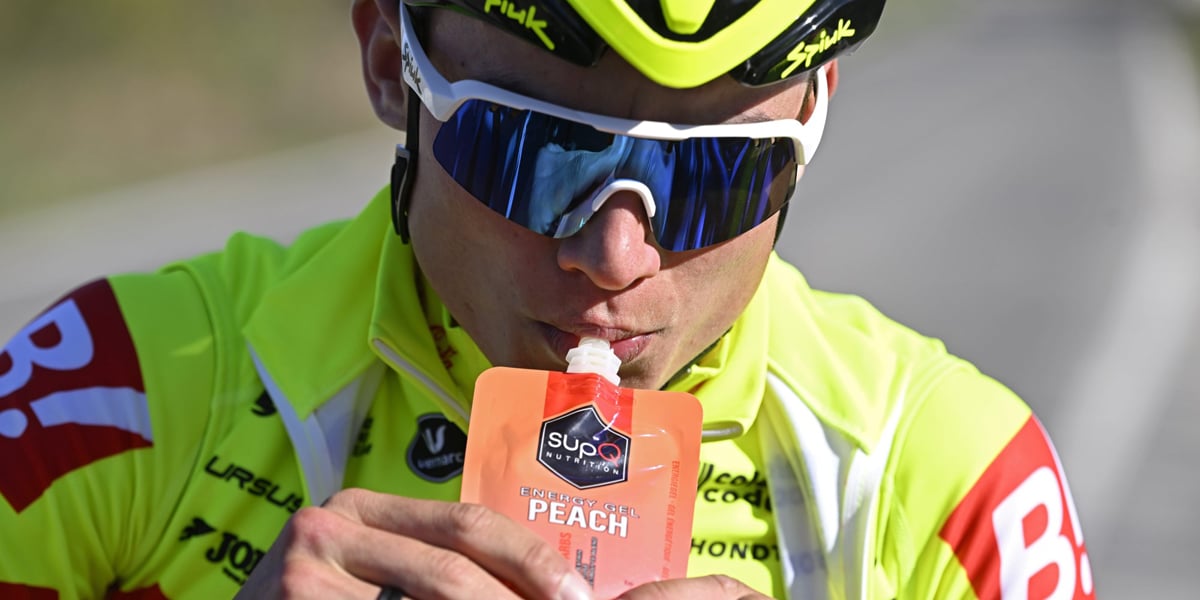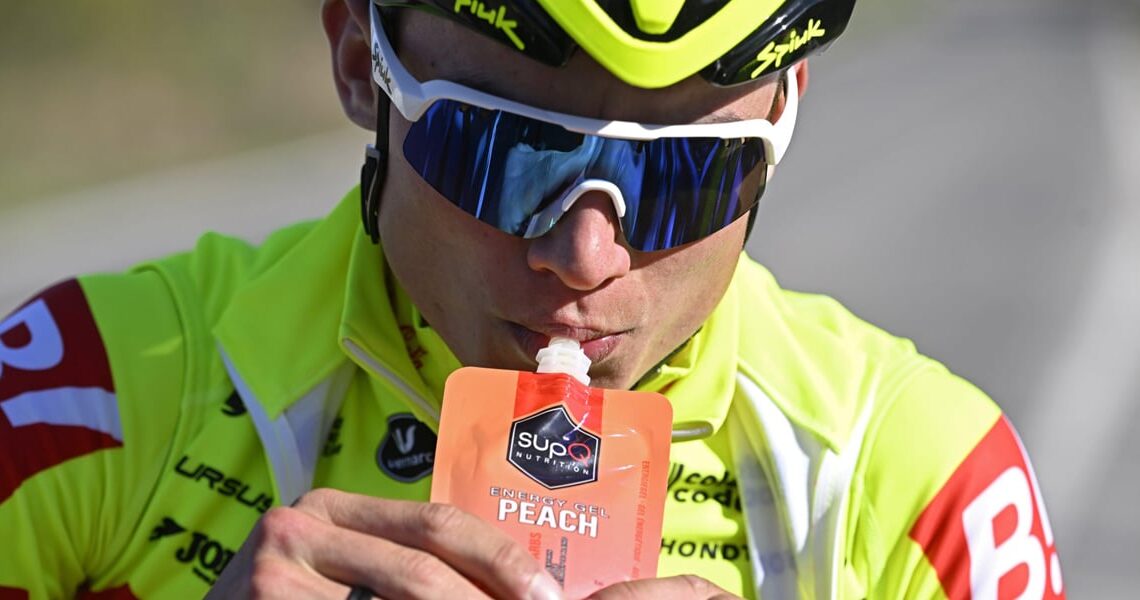
Sports gels are super easy and convenient ride fuel. But are you actually getting what you paid for? What is – or more importantly – what ISN’T in your gel?

In the spring of 2024, Reddit boards and endurance blogs were abuzz with controversy as Spring Energy gels came under fire. A runner and environmental chemist, attempting to recreate one of the company’s popular gels, began to suspect something was amiss with the claimed carbohydrate content on the nutrition label. Upon dehydrating the product to extract all the water and weigh-out the remaining carbohydrate, their suspicions were confirmed: the product had only 16 of the claimed 45 g of carbohydrate.
The controversy sent researchers, gels in hand, to the lab to investigate whether other nutrition companies were also falling short. In this article, we dive into the latest research on what is—and isn’t—in your energy gels.
As cycling and endurance sports (we hope) move beyond the days of carbohydrate restriction and low-carb diets into a more fuel-forward approach centered around consistent carbohydrate intake, many were taken aback by the gap between claimed and actual energy and carbohydrate content in Spring Energy’s Awesome Sauce Gel. Made with whole food ingredients like sweet potato, rice, apples, and maple syrup, these gels are often favored by ultra-distance athletes seeking something more palatable than maltodextrin as the hours and miles tick by. As you can imagine, trying to plan your nutrition for a long gravel race, bikepacking trip, or marathon MTB race, only to discover you were getting just 35% of the carbohydrates you thought, would be a significant problem.
The Research
Between March and May 2024, researchers analyzed several carbohydrate gels from brands like Huma, SIS, Honey Stinger, Maurten, Naak, Precision Hydration, GU, and Spring Energy. Using an FDA-accredited lab, samples were meticulously assessed. Upon identifying issues with Spring Energy’s Awesome Sauce, samples were sent to three different FDA-accredited labs to evaluate energy, macronutrient, and sodium content. In total, nine Spring Energy gels from seven different lots were analyzed—one of which was tested three times by different labs to verify consistency.
 Of the tested brands, calorie content was within 20% of the label for 7/8 brands (range: 0%–12%). However, Spring Energy’s Awesome Sauce contained 71% less energy than stated on the label (53.0 vs. 180.0 kcal) and 72% less carbohydrate (12.5 vs. 45.0 g). This significant nutritional gap suggests that athletes relying on Spring Energy as their primary fuel during events risked glycogen depletion early on. In contrast, most other brands had carbohydrate content variation with less than a 5% difference from the label. The exception was Näak’s Apple and Maple Syrup gel, which contained 12% less energy and 15% less carbohydrate than stated (1).
Of the tested brands, calorie content was within 20% of the label for 7/8 brands (range: 0%–12%). However, Spring Energy’s Awesome Sauce contained 71% less energy than stated on the label (53.0 vs. 180.0 kcal) and 72% less carbohydrate (12.5 vs. 45.0 g). This significant nutritional gap suggests that athletes relying on Spring Energy as their primary fuel during events risked glycogen depletion early on. In contrast, most other brands had carbohydrate content variation with less than a 5% difference from the label. The exception was Näak’s Apple and Maple Syrup gel, which contained 12% less energy and 15% less carbohydrate than stated (1).
Since the issue came to light, Spring Energy acknowledged the problem, attributing it to variations in rice cooking methods and an overly diluted apple sauce supplier. The company has since reformulated its product line. While the issue of product quality is by no means exclusive to Spring Energy, their acknowledgment and reformulation should be seen as a commendable act of good faith and transparency. The nutrition industry—especially in supplement manufacturing—is no stranger to issues of quality, content discrepancies, or contamination. This raises the question: Can we trust nutrition companies (2, 3, 4)?
Can You Trust Nutrition Companies?
Researchers have analyzed nutrition and supplement products against their labeling for decades, often uncovering inconsistencies. While concerning, some variance in nutritional content is allowed. Supplements, however, face limited pre-market approval processes with the FDA, leaving variance and contamination of products more of a reality.
For background, the FDA has three categories for food labeling accuracy (not for supplementation). Class I nutrients are added through fortification or fabrication, such as vitamins, minerals, protein, dietary fiber, and potassium, and must meet or exceed 100% of the label value. Class II nutrients, naturally occurring in foods, include vitamins, minerals, protein, total carbohydrates, dietary fiber, unsaturated fats, and potassium, and must meet at least 80% of the stated value. Group III nutrients—calories, sugars, total fat, saturated fat, cholesterol, and sodium—must not exceed 120% of the listed values. These allowances account for differences in raw material content, storage conditions, cooking processes, and other factors, and while frustrating, they are expected.
This may surprise many in cycling and endurance sports, where a ±20% variation in anything is highly significant, and the variance in Spring Energy was well above that which is allowed. As alarming as this may be, the Spring Energy controversy should likely be seen as an outlier rather than representative of the industry as a whole. This case also underscores the importance of anecdotal evidence and feedback from coaches and athletes in identifying issues and using an individualized nutrition approach. Fortunately, energy variations in nutrition products are generally not this high, nor are they a safety concern—unlike the supplement market, where limited quality control and a lack of pre-market approval have led to high rates of contamination and inconsistency (5).
Third-Party Verification
If you’re looking to minimize variation or improve the quality of your nutrition, choosing companies that prioritize quality control is a good starting point. Many brands register their products with third-party organizations such as Informed Sport, BCSG, and NSF for Sport, which test for banned substances and content accuracy. Others, like USP, test for quality but not banned substances (6, 7, 8, 9). These organizations provide online search tools to help consumers find certified products. Additionally, websites like Consumer Labs and Consumer Reports offer product reviews and analysis, enabling informed choices in the marketplace (10, 11).
For the most part, athletes shouldn’t worry about large discrepancies between stated and actual energy content. Most manufacturers employ teams of food engineers to validate their nutrition claims using best practices. While athletes meticulously analyze power data and training, applying the same level of scrutiny to calorie counting and food-tracking can lead to over-preoccupation with food and a less intuitive relationship between food, body, and mind.
Summary
The Spring Energy controversy reminds us that while most nutrition companies aim for accuracy, occasional discrepancies occur. Athletes can protect themselves by relying on third-party tested brands, understanding FDA guidelines and their limitations, and staying flexible in their nutrition plans. Trusting your products is essential, but so is listening to your body, staying attuned to your performance nutrition, and consulting a registered dietitian when needed. By doing so, you can remain confident in your preparation, performance, and nutrition.

References
- Tiller, N. B., Burke, L. M., Howe, S. M., Koop, J., Ohm, J. R., & Burgess, B. (2024). What’s (Not) in Your Supplement? An Energy and Macronutrient Analysis of Commercially Available Carbohydrate Gels. International Journal of Sport Nutrition and Exercise Metabolism (published online ahead of print 2024). Retrieved Jan 20, 2025, from https://doi.org/10.1123/ijsnem.2024-0174
- Aly, M.O., Ghobashy, S.M. & Aborhyem, S.M. Authentication of protein, fat, carbohydrates, and total energy in commercialized high protein sports foods with their labeling data. Sci Rep 13, 15359 (2023). https://doi.org/10.1038/s41598-023-42084-3
- Zapata-Muriel, A., Echeverry, P., Van Dusseldorp, T. A., Kurtz, J., & Monsalves-Alvarez, M. (2022). Measured versus label declared macronutrient and calorie content in Colombian commercially available whey proteins. Journal of the International Society of Sports Nutrition, 19(1), 258–266. https://doi.org/10.1080/15502783.2022.2090828
- Zhang, X., O’Kennedy, N., & Morton, J. P. (2015). Extreme Variation of Nutritional Composition and Osmolality of Commercially Available Carbohydrate Energy Gels. International Journal of Sport Nutrition and Exercise Metabolism, 25(5), 504-509. Retrieved Jan 20, 2025, from https://doi.org/10.1123/ijsnem.2014-0215
- Zapata-Linares, J., & Gervasini, G. (2024). Contaminants in Dietary Supplements: Toxicity, Doping Risk, and Current Regulation. International journal of sport nutrition and exercise metabolism, 34(4), 232–241.
- NSF International. (n.d.). Certified products. Retrieved January 20, 2025, from https://www.nsfsport.com/certified-products/
- We Test You Trust. (n.d.). We Test You Trust – Certified products for sport. Retrieved January 20, 2025, from https://sport.wetestyoutrust.com/
- Banned Substances Control Group. (n.d.). BSCG – The gold standard in dietary supplement certification. Retrieved January 20, 2025, from https://www.bscg.org/
- U.S. Pharmacopeia. (n.d.). USP verified mark. Retrieved January 20, 2025, from https://www.usp.org/verification-services/verified-mark
- ConsumerLab. (n.d.). ConsumerLab.com – Independent tests and reviews of vitamins, supplements, and nutrition products. Retrieved January 20, 2025, from https://www.consumerlab.com/
- Consumer Reports. (n.d.). Consumer Reports – Product reviews and ratings. Retrieved January 20, 2025, from https://www.consumerreports.org/
The post What Isn’t in Your Carbohydrate Gel? appeared first on PezCycling News.




